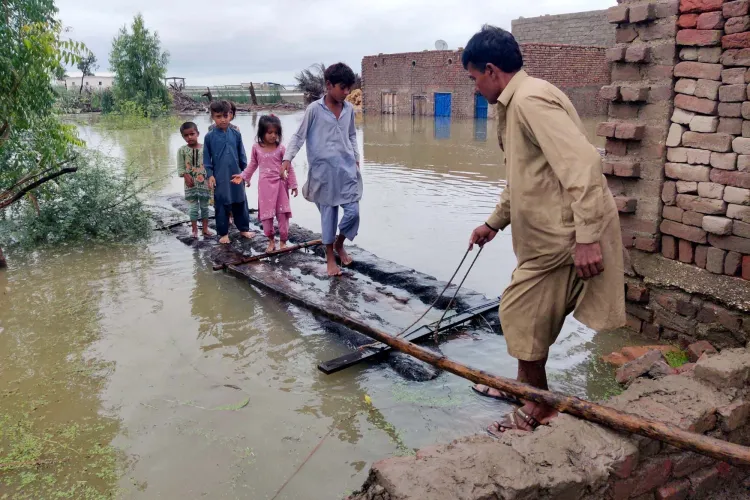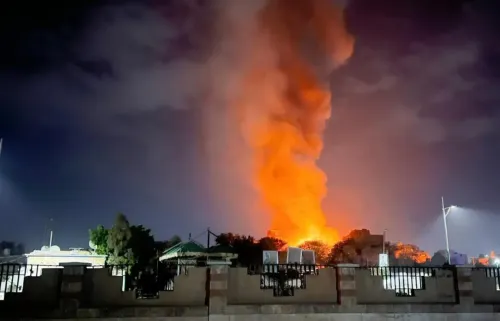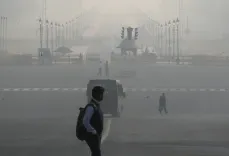How Are Climate Hazards Transforming Infrastructure Failures into Humanitarian Crises in Pakistan?

Synopsis
Key Takeaways
- Pakistan faces severe climate hazards affecting millions.
- Infrastructure failures are exacerbating humanitarian crises.
- Glacial instability and intense rainfall contribute to disasters.
- Improved planning and resilience are essential.
- Recent floods highlight the need for urgent action.
Sofia, Nov 26 (NationPress) The nation of Pakistan is grappling with multiple climate hazards such as heat stress, glacial instability, and severe rainfall, which collectively exacerbate infrastructure failures into significant humanitarian crises, as reported on Wednesday.
This year's floods have impacted approximately 33 million individuals, displacing countless families, devastating farmland, and resulting in numerous fatalities, as highlighted by the Bulgaria-based publication Modern Diplomacy.
The floods were further complicated by mountain-related risks like Glacial-Lake Outburst Floods (GLOFs) in the summer months within Pakistan-occupied Gilgit-Baltistan, destroying various homes and creating large, newly emerged lakes that disrupted road access and tourism in delicate mountain economies.
The destruction of homes, guesthouses, and the economic foundation of those living in mountainous areas illustrates how poorly planned transportation and tourism infrastructure can amplify the adverse effects of climate-induced glacier changes.
In 2025, Pakistan also faced extreme heatwaves, with urban and rural areas recording temperatures significantly above seasonal averages. April was noted as the second-hottest month in 65 years, with a national mean temperature approximately 3.37 degrees Celsius above historical averages.
"Heat stress directly affects labor productivity, public health, and the operability of energy systems, increasing demand precisely when supply is least reliable. The anticipated return of La Nina this winter will test Pakistan's resilience yet again, as fluctuating temperature and rainfall patterns will expose how vulnerable communities, ecosystems, and infrastructure are to a changing climate. In essence, Pakistan is facing a convergence of hazards, including heat stress, glacial instability, and intense rainfall that turns infrastructure failures into humanitarian disasters," Arooj Saghir wrote in Modern Diplomacy.
"Why do these predictable clashes between humanity, nature, and climate persist? Why are recurring infrastructure failures still evident? What value does growth hold if it is lost each year? Why do villages continue to suffer losses, why do roads erode, why do power systems fail, and why do communities bear the brunt of these disasters? The patterns are recognizable: inadequate spatial planning that disregards biodiversity and hydrology, weak enforcement of Environmental Impact Assessments (EIAs) and social protections, flawed compensation and resettlement processes that leave families more impoverished and vulnerable, and infrastructure designed based on past standards rather than future climatic conditions," she added.
As rainfall becomes more intense, drainage systems and bridges fail, hydraulic structures are insufficient, and embankments along rivers such as the Chenab, Sutlej, and Ravi are compromised because they were not updated to accommodate altered water flow, increased rainfall, or upstream glacial melt.
"Most infrastructure continues to be constructed with outdated climate considerations, utilizing monsoon design storms and flood embankments calibrated for rainfall intensities from decades ago. As rainfall intensifies, drainage systems and bridges collapse, and hydraulic structures are inadequate. Embankments along rivers like the Chenab, Ravi, and Sutlej are overtopped or breached due to lack of upgrades to meet changing flow patterns, upstream glacial melt, or increased rainfall driven by La Nina cycles.
"The recent floods revealed how urban drainage systems and river embankments—often built or modified without comprehensive watershed assessments—were overwhelmed. Releases from upstream reservoirs and poorly coordinated cross-border water management further exacerbated downstream consequences. Constructing dams and roads without resilience is no longer progress; it is a short-sighted policy. Where accountability is minimal and safeguards are procedural rather than substantive, projects advance based on convenience rather than resilience, and the most vulnerable pay the highest price," the report emphasized.









